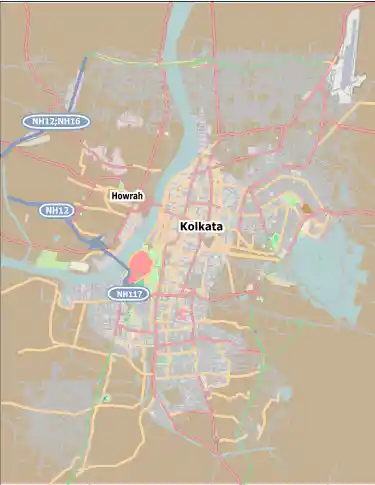THE DARK LANES OF SONAGACHI
Sonagachi which also means the ‘Tree of Gold’ is one of the most famous red-light districts in Asia. With a distinctive history of its own, the story of Sonagachi has travelled a long way.

The map of Kolkata. Image Courtesy: Wikimedia Commons
The dark lanes of Sonagachi, Kolkata shines bright when the sun sets down, popping up with the bright sarees and heavy makeup of numerous women standing in the doorway of their houses, waiting for a man who is ready to pay her for his sleep.
The story of one of the largest red-light areas in Asia dates back to the time when the dacoit Sanaullah lived there with his mother. On his death, the grieving woman heard a voice emanating from her hut, allegedly the voice of his son, asking her to stop crying because he has become a Gazi. This led to the legend of Sona Gazi. Gazi in Arabic means a saint, and people started to visit his hut in thousands to get the blessings or a remedy for their sufferings.
It is believed that his mother constructed a mosque in his honour. However, after her death, that mosque fell into disuse and disappeared after some time. The lane where Sanaullah lived came to call Sonagachi, which also means ‘Tree of Gold’. No one would have ever imagined at that time that this lane would become Asia’s largest brothel.
Well, one question that arises in all of our minds is how did this area turn into a red-light district in the first place. There is no concrete evidence that helps us to understand why Sonagachi developed in this particular way. However, it is believed that the location of Sonagachi from the 18th century onwards is believed to be one of the major reasons for the emergence of this famous brothel.
The geographical location of Sonagachi made it a popular area for pilgrims as well as traders. It was near the trading areas and made it one of the most visited spots. Many assume that the reason traders, merchants and pilgrims travelled through Sonagachi, the development of a brothel was inevitable.
The rich Bengali families invested in the lands and rented out houses to these women. The rich spoilt brats who had a surplus to spend on their pleasure and satisfaction visited these dingy lanes regularly. The scene was a paradox in itself when rich ‘princes’ travelled in chariots and horse-drawn carriages to get into the muddy and dirty lanes of the brothels where women waited for a man to accept her services.
The sex trade is passed down for generations, with women of all ages belonging to the same family offering their bodies for service. The legend also states that women belonging to the Mughal harem travelled down to Sonagachi after the empires fell out of favour and disintegrated.
Yet, the generations of women working here, establishing their businesses and clientele, this place is not without human trafficking, rapes and forceful work to earn their livelihood. For years, women are forced to sell themselves to survive in a world where people treat them as nothing but a slave. Their kids are denied the right to get an education or the basic amenities. If a woman tries to run away from the said establishment, they are physically abused and raped, emotionally tortured until they get accustomed to their situation and accept the face of reality.
One might be surprised to know that in the land of sex workers where the same women are treated as inhumane, porters and ideal makers collect the soil of the same land to use in making idols during Durga pooja. The legend states that a priest or a porter must beg for the soil from a brothel as it is 'punya mati' or the sacred soil that contains the blessings of the one gifting. According to the tradition, when one visits the ostracized lanes of a brothel, they leave behind their piety at the doorstep before indulging in their desires and sins. This piety gets mixed in the soil, making it a sacred land with virtues and blessings.
While some believe in the above tradition, another legend based on the Vedas state that during Durga Pooja, nine classes of women or Navkanyas are to be worshipped. A nati (dancer), a vaishya (prostitute), rajaki (laundry girl), a brahmani (Brahmin girl), a shudra, a gopala (milkmaid). the worship of the ten-armed goddess is incomplete without worshipping the navkanyas.
Such traditions prove the paradox of judgement and believes we live in. While on one hand, prostitutes are considered as dirty and a shame to society, the same society seeks their blessings during Durga pooja.
While some might work out of pure consent, others are forced into this industry. The red-light industry makes millions of rupees every year directly and indirectly. This particular area showcases the bias where monetary value is measured as the superior value when weighed with humanity.
Various NGOs have tried to change the course of these women’s life along with a chance for their kids to get out of these generations’ bound environment and get a chance to live a life of their choice.
The dingy lanes of Sonagachi shine when the women wear the blingy sarees. Yet, it’s the lanes that portray the emotions of the women better than any façade they adorn.

Sonagachi, Kolkata. Image Courtesy: Wikimedia Commons


